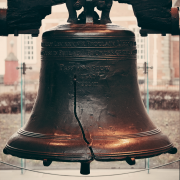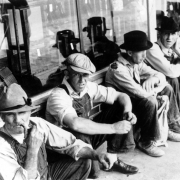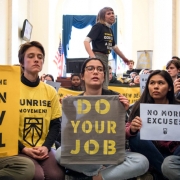“Until you do it, I’m the boss,” said Alexandria Ocasio-Cortez, the socialist congresswoman from the Bronx, responding to critics of her Green New Deal in February. Later that night, the freshman congresswoman doubled down on her comment, tweeting that people who “don’t like the #GreenNewDeal” should “come up with your own ambitious, on-scale proposal to address the global climate crisis. Until then, we’re in charge—and you’re just shouting from the cheap seats.”
Much has rightly been made of the Green New Deal’s fuzzy-headed utopianism and its impossible goal of reducing U.S. greenhouse gas emissions to net-zero in 10 years. But we should also pay close attention to the plan’s authoritarian impulses, particularly in light of its historical inspirations: Franklin D. Roosevelt’s New Deal and the command economy he established during the Second World War.
If proponents of the Green New Deal are serious—and there’s no reason to doubt them—then they’re proposing a return to a militaristic America where Uncle Sam’s heavy hand intervenes in all aspects of life, curtailing individual freedom in pursuit of their collectivist goals. And like the planners of the Roosevelt years, their intentions are clear and grandiose: They want the power to regiment a society of nearly 330 million people in pursuit of a pipe dream they liken to a war for survival.
‘The New Deal and the Analogue of War’
After FDR defeated Herbert Hoover in 1932, the new president rolled out his first New Deal to confront the Great Depression. Roosevelt saw the economic collapse as directly analogous to war. In his first inaugural address, he said that Americans “must move as a trained and loyal army willing to sacrifice for the good of a common discipline, because without such discipline no progress is made, no leadership becomes effective.”
Like President Woodrow Wilson during World War I, President Roosevelt and his New Dealers moved to cartelize the economy with the enthusiastic support of business executives such as Gerard Swope, president of General Electric. “There was scarcely a New Deal act or agency that did not owe something to the experience of World War I,” according to FDR scholar William E. Leuchtenburg in an excellent paper published in 1964, “The New Deal and the Analogue of War.”
The best example of this was the creation of the National Recovery Administration (NRA), which was essentially a peacetime version of Wilson’s War Industries Board (WIB). Headed by the Wall Street financier Bernard Baruch, the WIB coordinated purchases, allocated commodities, and fixed “prices and priorities in production” while guaranteeing a profit to the big business that helped fuel the war machine.
If the WIB could coordinate an economic mobilization during wartime, the Roosevelt administration thought, then a peacetime equivalent could defeat the Great Depression by mobilizing America’s productive powers. The NRA held industries to “codes of fair competition,” which set wages, working hours, and prices. By doing so, Roosevelt and his New Dealers believed they were overthrowing the cut-throat and chaotic competition they blamed for the Depression.
Companies that didn’t cooperate with the NRA were ostracized. Under the NRA’s Blue Eagle Campaign, businesses that played ball were given a blue eagle symbol for their windows and packages to advertise their adherence to the administration’s rules and regulations. Those that didn’t faced boycotts. As General Hugh Johnson, head of the NRA, put it, “Those who are not with us are against us.” Some businessmen who violated NRA regulations were arrested.
Socialist leader Norman Thomas called this “a scheme which in essence is fascist.” The NRA itself issued a report that stated, “The Fascist Principles are very similar to those we have been evolving here in America.” In 1935, the Supreme Court ruled the NRA’s “codes of fair competition” unconstitutional, saying they violating the Constitution’s separation of powers as well as the Commerce Clause. Small wonder that New Left historians accused the agency of championing a corporatist economy.
The Green New Dealers should also be wary of using the original New Deal’s Civilian Conservation Corps (CCC), which sent young unemployed and unmarried men onto federal, state, and local government lands for conservation purposes, as a model. In her defense of the Green New Deal at The Intercept—aptly titled “The Battle Lines Have Been Drawn on the Green New Deal”—Naomi Klein cites the CCC as an inspiration, noting that it began with 200,000 volunteers but then expanded dramatically due to its popularity. She doesn’t mention that the CCC was really an Army program with a titular civilian head.
Leuchtenburg points out that the CCC was “consciously devised to provide the moral equivalent to war” and that it “aimed to install martial virtues in the nation’s youth.” When the men woke up in their army tents in camp, they heard “Reveille.” During lights out, they heard “Taps.” It shouldn’t be surprising that when the draft returned in 1940, as Charles E. Heller writes, CCC alumni “provided the pretrained manpower to fill the U.S. Army’s ranks upon mobilization with men who readily assumed the role of Non-Commissioned Officers.”
The World War II Homefront
But then, the Green New Dealers seem to see that war as a model for domestic policy. In a widely lampooned FAQ document that an Ocasio-Cortez advisor erroneously claimed was a hoax, the Green New Deal is called a “10-year plan to mobilize every aspect of American society at a scale not seen since World War 2 to achieve net-zero greenhouse gas emissions and create economic prosperity for all.”
Americans should pay attention to what the country was like on the homefront during World War II. Prosperity it was not.
Unemployment did come down—to less than 2 percent—though that’s largely because more than a fifth of the U.S. workforce was conscripted and sent overseas to sacrifice life and limb. The workers who remained were focused on producing military goods, such as guns and ammunition, while consumer goods were either underproduced or not produced at all. Other goods—such as gasoline, tires, nylon, shoes, bicycles, sugar, meat, canned fish, cheese, and canned milk—were strictly rationed. Income tax rates applied to more and more people, including lower-income earners; hit confiscatory levels, with the highest marginal tax rate rising to 94 percent; and were rigorously enforced by the IRS through a new system of automatic payroll deductions.
American people did extraordinary things to win World War II, but it took an authoritarian society to achieve it—one that nobody should want to return to.
When the United States goes abroad to do widescale social engineering, that’s rightly called imperialism by libertarians and socialists alike. But when widespread social engineering is done at home through the federal government, people like Ocasio-Cortez call it progressivism and point to the New Deal and World War II to sell the plan.
When she says “I’m the boss,” pay attention. She’s describing America under a Green New Deal: a place where you’ll do as you’re told.













